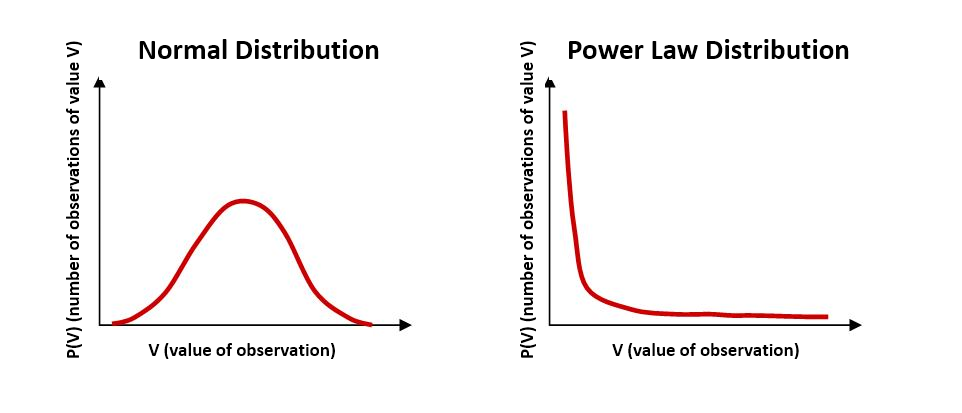Is Your Fundraising All Dots, No Pattern?
We report average gift as gospel. And if the giving by your donors looks like the normal, bell curve on the left then average and how tall or wide the middle part is will give you much of what you need. This world view assumes outliers are distraction. How many times have you or your agency removed the “outlier” gifts to report the average?
Human height, blood pressure, intelligence and a lot of randomness are Normal, the curve on the left. The power curve (right) describes the frequency of word use, size of human settlements, the distribution of internet traffic, the intensity of earthquakes and any system with “power” users.
In a power world reporting the average tells you nothing about what’s really going on. In this world you’ve got two interesting dynamics, the long tail and the highly skewed action at the other end. Your 80/20 rule, Pareto.
How much of your world is a power world? You likely get most of your dollars from a small number of donors. Your gift frequency per donor/per year is highly skewed and follows a power curve. Flip the power curve below and it matches your return from solicitation volume. Big gains going from 0 solicitations to 1, and 1 to 2 and 2 to 4 but hardly any going 10 to 12 to 14. 
Here’s the challenge. Most of our systems and org culture is geared towards the Normal distribution world. We treat all donors the same, which means we think there is an average donor and we build our test and control world around this non-existent, average donor.
Living in the Normal world is where efficiency and incremental gain live. You build standardized process and design to serve “average customers”. We force this Normal Distribution thinking with our hierarchical org charts, division of labor, cost accounting, etc.
Here’s the thing, it’s really hard to move the average; average gift, average output, average cultural competence. And here’s the big thing, it’s a lot of wasted time and effort trying to move the middle if you’re actually operating in a Power World.
In a Power World the ‘extremes’ make a really big difference in outcomes. The simple example – a $10,000 gift to your appeal. Rather than treat this as anomaly or outlier, what if your time and energy is spent studying this?
In a power world things are more interconnected. And doesn’t your world feel more interconnected? Your supply chain, the geographic spread of your labor pool?
Here’s the best part. In a power world the cause of big change tends to be a single, generative idea. This is what some call scale-free theory or deep simplicity.
What the hell does that mean?
- In a normal curve world you process dots. In a power world we look for patterns. If you focus on campaign results versus lifetime value you’re forcing a normal curve on a power world.
- In a normal world we examine the offer, the creative and the message in a vacuum. We think the March appeal cause of success and failure is isolated from Feb and April results.
- In a normal world we think adding channels is going to move the average. In a power world you are simply shifting dollars, the average stays about the same.
- In a power world, the thing that caused success and failure is mostly the same for a given context.
- That means, for example, unearthing why people do what they do and how it differs by who the person is scale-free theory. It’s got exponential and interconnected impact if you apply it across your entire program. The “Why” cuts across acquisition, house appeals, sustainer, lapsed, mid level, major.
In a power world all the cool stuff with a chance to fundamentally change your program is happening outside convention.
Kevin



Kevin
The simplistic use of “averages” in fundraising research and reporting is unfortunate. This is particularly true of the thousands of solo fundraisers and even many of the training programs swear by these averages. Over my decades of fundraising, I actually believe it has suppressed aspirational funds raised.